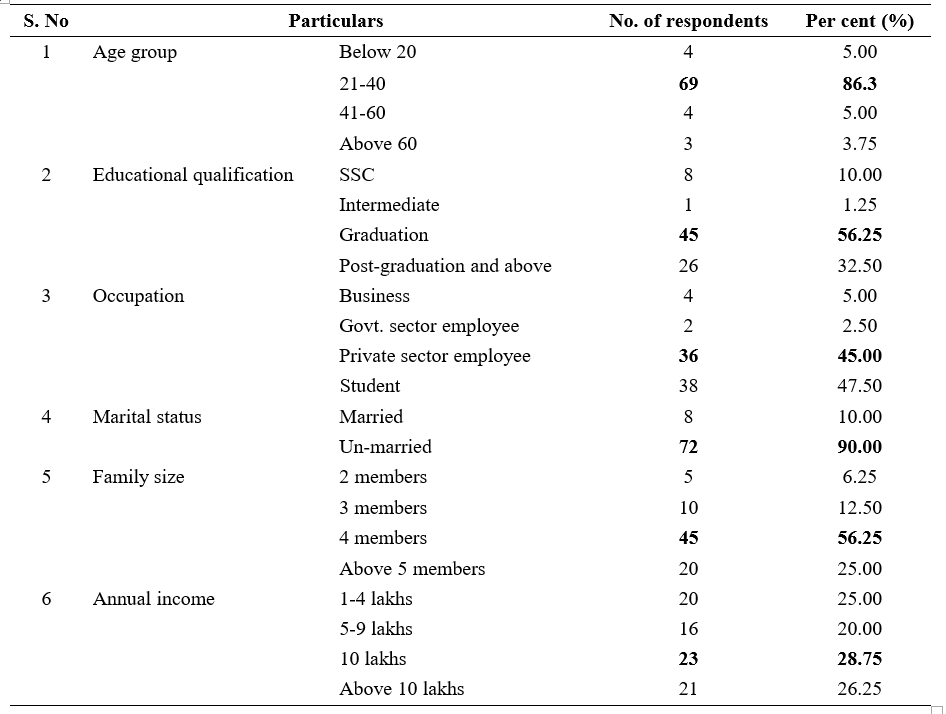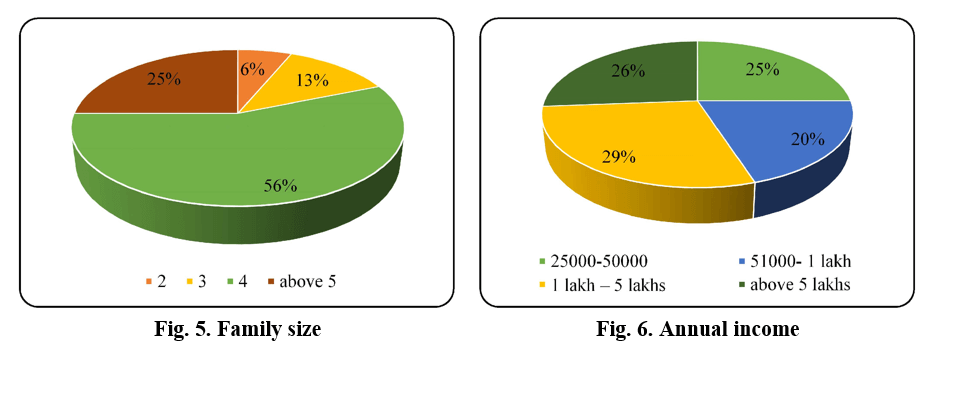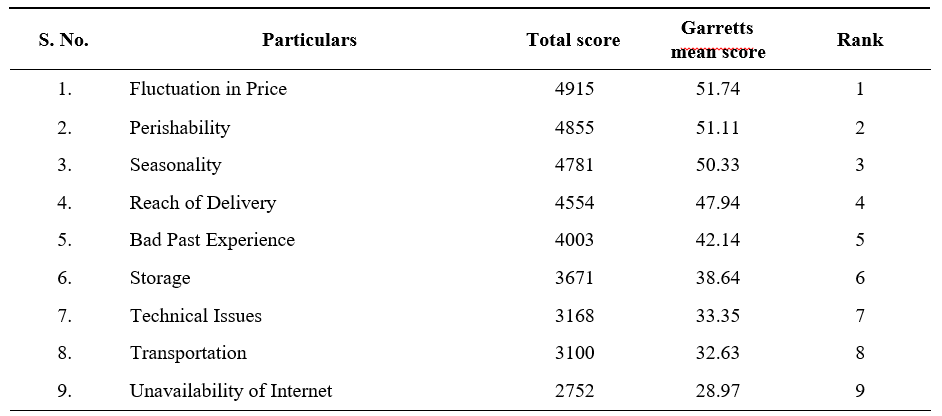Constraints in Purchasing Fruits and Vegetables Through E-commerce Sector
0 Views
LAVANYA NARIGE*, B. APARNA, N. VANI AND G. MOHAN NAIDU
Department of Agribusiness Management, S.V. Agricultural College, ANGRAU, Tirupati – 517502
ABSTRACT
The present study is intended to understand the Consumer perception towards fruits and vegetables. E-Commerce business of selling vegetables and fruits through internet has been recently introduced in some metropolitan cities where online retail outlets of both vegetables and fruits have been expanding. A representative sample of 80 consumers from Bengaluru and Tirupati cities purchasing fruits as well as vegetables through online retail outlets were taken for the present study. Primary data was collected through personnel interviews with the help of a well-structured questionnaire based on objectives required. The data collected was analysed using both quantitative and qualitative research techniques. Mainly the data collected was tabulated and analysed using appropriate statistical tools such as Percentage analysis and Garrett’s ranking technique. From the investigation it was found that majority of sample consumers having experience over internet usage was more than 5 years. 68.75 per cent of the consumers verify retail stores while purchasing fruits and vegetables online. Consumers purchase fruits and vegetables frequently through internet. Consumers face the problem of seasonality due to online purchase of fruits and vegetables was about 55.00 per cent.
KEYWORDS: Consumer Perception, E-commerce, Fruits and Vegetables.
INTRODUCTION
India has been growing drastically in terms of internet use, from 2010 and the percentage of users has gone up from 7.5 per cent to 50 per cent. Now-a-days the onset of lockdown and a push towards digitization proved to be a blessing to e-commerce as consumers resorted to online shopping. It became a backbone for supplying essentials to the more than 1.3 billion people of India. The growth of e-commerce in India will help the country to become a major force in the e-commerce business with an estimated growth potential that will be of $100 billion by the year 2024.
E-commerce (Electronic Commerce) is the activity of online buying and selling of commodities over the internet. It draws on technologies such as mobile commerce, electronic funds transfer, supply chain management, internet marketing, online transaction processing etc. It provides direct interaction between the consumers and the products (or) services that can shape up fruitful relationships. Today, the volume of trade digital payments using e-commerce has also been expanding. There has been an increase in e-commerce business due to good access to internet in both rural and urban areas.
Online fruits and vegetables shopping has became more popular now-a-days with the growing internet connectivity and raising popularity of electronic shopping. As, about 30 per cent of fruits and vegetables production is being wasted which is more than their consumption. As, one can see a clear need waiting to be served through technology-based intervention. Entrepreneurs have identified the opportunity of opening online fruit and vegetable stores.In this hustle and bustle of modern lifestyle with long working hours and heavy traffic people associate shopping at fruit and vegetable market as tiresome and stressful. People are willing to spend their time and energy on purchasing of fresh fruits and vegetables through e-commerce which can increase their healthy consumption and reduced the wastage at retailer’s level. Most of the existing e-retailers offer their services in metros and major urban centres targeting the urban population having a wide consumer base viz., working couples, nuclear families, students fending for themselves, new mothers, senior citizens and large families.
E-commerce websites and services in Bengaluru and Tirupati cities are on rise now-a-days as people’s demand and preferences for online purchasing of fruits and vegetables keeps on increasing. Their main goal is to provide the consumers with digital support and services that highlight their product and specialties to the users. The e-commerce website development in both the cities offers consumers multiple product options, trust, transparency and they have the best and the finest strategies to deliver the products.
Fruits and vegetable service focus on user interface (UI) and user experience (UX) which are very crucial to a website as they contribute to the presence, overall look and appearance of the website. The e-commerce designers play a key role in converting and integrating websites on the various trends and competitions making them strong and successful in the online market. Their procurement model includes a convenient mix of warehousing and just- in-time (JIT) deliveries from a host of suppliers including FMCG companies.
As, the consumer find a wide collection of goods, great pricing and convenience with exceptional levels of customer services i.e., preferred delivery times, same day deliveries and also attract consumers to purchase a large variety of products by providing a sales promotion or discount code, making it more cost effective. Timely delivery of fresh and desired produce is done by efficient and reliable suppliers within the allotted time. They are also open to take product feedback from their consumers.
Some of the established e-commerce sectors like bigbasket.com, villageagro.com, freshmigo.com, ninjakart.com, jiomart.com, reliancefresh.com etc. in Bengaluru and Tirupati cities are offering wide collection of goods. Hence, there is a need to study the consumer behavior and their preferences towards online purchasing of fruits and vegetables.
MATERIAL AND METHODS
The survey was conducted in Tirupati and Bengaluru city. E-Commerce business of selling vegetables and fruits through internet has been recently introduced in some metropolitan cities. Thus Bengaluru (tier-1) and Tirupati (tier-2) cities where online retail outlets of both vegetables and fruits have been expanding were selected purposively for the present study. A representative sample of 40 respondents from Bengaluru and 40 respondents from Tirupati cities purchasing fruits as well as vegetables through online retail outlets were selected by using simple random sampling technique. Primary data along with secondary data were collected for the study. Primary data was collected through personnel interviews with the help of a well-structured questionnaire based on objectives required. Secondary data was collected from the appropriate sources such as articles, journals, company reports, etc. The data collected was analyzed to attain the stated objectives by using frequencies, percentages and Garrett’s ranking technique.
Tools and Analysis
The data collected were subjected to appropriate set of statistical tools to arrive at valid conclusions. Data was statistically analyzed using SPSS program.
Frequencies and Percentages
Some of the data were also interpreted in terms of their frequencies and percentages wherever necessary to know the distribution patterns of respondents according to variables.
Garrett’s Ranking Technique
To find out the most significant factor which influences the respondent, Garrett’s ranking technique was used. As per this method, respondents have been asked to assign the rank for all factors and the outcomes of such ranking have been converted into score value with the help of following formula:

where,
Rij = rank given for ith factor by jth individual
Nj = number of factors ranked by jth individual
With the help of Garrett’s table, the percent position estimated is converted into scores. Then for each factor, the scores of each individual are added and then the total value of scores and mean values of the scores are calculated. The factors having highest mean value is considered to be the most important factor.
Age plays a major role in segmenting the market as consumers of different age groups possess distinct needs and wants. It is observed from the table that, majority of the consumers are in age group of 21-40 years (86.3%) followed by age group of below 20 and 41-60 years each with 5.00 per cent and above 60 years (3.75%). Thus, it
Table 1. Socio-economic characteristics of sample consumers

was observed that the majority of the consumers were in middle age group of 21-40 years as this age group consumers mostly use mobiles which is a key source for their frequent usage of internet (Changohit, 2006).
Out of the total sampled consumers, 56.25 per cent of the consumers hold a graduation degree, 32.50 per cent of the consumers hold post-graduation degree, and 10.00 per cent of the consumers hold a qualification up to SSC and 1.25 per cent of the sampled consumers have occupied the category of intermediate. Thus, it was found that the majority of the consumers were graduates as they have profound knowledge on internet. post-graduates also use mobiles frequently and are habituated to online shopping.
Occupation plays a vital role in selecting the product, specific brand and consumers purchase behavior. It was observed that among sampled consumers, 47.50 per cent were private sector employees, 45.00 per cent were government sector employees, 5.00 per cent consumers were doing business, 2.50 per cent were students. Thus, it was observed that the majority of the consumers were private sector employees and government sector employees. They get mostly attracted to e-commerce easily as they are busy in their work schedule and long working hours.
Out of 80 sample consumers, 90.00 per cent of consumers were un married and 10.00 per cent were married. The marital status of the consumers reveals that greater per cent of sample consumers were un-married because most of the un-married people like students, working men and women have no time to buy fruits and vegetables outside with their busy schedules.


Table 2. Constraints in purchasing of fruits and vegetables through E-commerce

Out of 80 sampled consumers,56.25 per cent of the sampled consumers had four members in the family, 25.00 per cent of the consumers had above five members in the family, 12.50 per cent of the consumers had 3 members in the family and 6.25 per cent of the consumers had two members in the family. Thus, the majority of the respondents had four members in the family as there are more proportion of small families in the present society when compared to singles and joint families (Rani et al., 2018).
Income levels of the people plays a major role in selecting the product in terms of quality and quantity. It was found that out of 80 sample sizes of consumers, the annual income of 28.75 per cent of the consumers is around 10 lakhs whereas 26.25 per cent of the consumers earn above 10 lakhs per annum, 25.00 per cent earn around 1-4 lakhs per annum and 20.00 per cent of the consumers earn 5-9 lakhs per annum. It is, thus, observed that the majority of the consumers fall under the income group of 10 lakhs. As fruits and vegetables occupies a premium market, income levels of the people have an absolute effect on its sales. Hence, the high income i.e., above 10 lakhs per annum has a major role in segmenting the market (Taruna, 2017).
Constraints in purchasing of fruits and vegetables through E-commerce sector
Information regarding constraints in purchasing of fruits and vegetables through e- commerce sector was analysed with the help of Garett ranking technique
(Kanchan et al., 2015) and it is collected and presented in the Table 2.
It is observed that ‘fluctuation in price’ was the first ranked constraint in purchasing of fruits and vegetables through e-commerce sector with mean score of 51.74, ‘perishability’ was the second ranked constraint with mean score of 51.11, ‘seasonality’ is the third constraint with mean score of 50.33, ‘reach of delivery’ is the fourth ranked constraint with mean score of 47.94, ‘bad past experience’ is the fifth ranked constraint with mean score of 42.14, ‘storage’ is the sixth ranked constraint with mean score of 38.64, ‘technical issues’ is the seventh ranked constraint with mean score of 33.35, ‘transportation’ is the eighth ranked constraint with mean score of 32.63, ‘unavailability of internet’ is the least ranked constraint with mean score of 28.97. Majority of the consumers have opted for fluctuation of price as a major constraint for purchasing fruits and vegetables through e-commerce. The consumers felt that due to the market forces like demand and supply the online prices of fruits and vegetables will be fluctuating (Ramesh and Arumugam, 2019).
Constraints in purchasing fruits and vegetables purchased through e-commerce sector reveals that majority was high with the fluctuation in price.
It is required to provide a wide variety of products to satisfy the needs and wants of customers because consumers were not convinced with the range of product available with online stores.
Certain age group people think that there is insufficient information with online shopping websites. Therefore, maximum information should be provided to the consumers.
LITERATURE CITED
Changchit, C. 2006. Consumer perceptions of online shopping. Issues in Information Systems. 7(2): 177-181.
Kanchan, U., Kumar, N and Gupta, A. 2015 A study of online purchase behaviour of consumers in India. ICTACT Journal on Management Studies. 1(3): 136-142.
Rani, S.V.F., Jayalakshmi, S and Gururaj, A.D. 2018. Statistical analysis on consumer’s perception towards consumption of green products with special reference to Chennai city. International Journal of Civil Engineering and Technology (IJCIET). 9(11): 333-340.
Taruna. 2017. A study on consumer perception towards online shopping. International Journal of Engineering Research and Technology (IJERT). 5(11): 1-4.
Ramesh, S and Arumugam, S.K. 2019. Problem solved by online consumers- a garret ranking approach. Management Science Letters. 9: 577-584.
- Genetic Divergence Studies for Yield and Its Component Traits in Groundnut (Arachis Hypogaea L.)
- Correlation and Path Coefficient Analysis Among Early Clones Of Sugarcane (Saccharum Spp.)
- Character Association and Path Coefficient Analysis in Tomato (Solanum Lycopersicum L.)
- Survey on the Incidence of Sesame Leafhopper and Phyllody in Major Growing Districts of Southern Zone of Andhra Pradesh, India
- Effect of Organic Manures, Chemical and Biofertilizers on Potassium Use Efficiency in Groundnut
- A Study on Growth Pattern of Red Chilli in India and Andhra Pradesh

